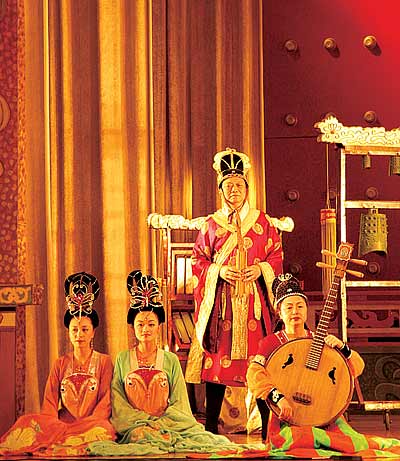| Tools: Save | Print | E-mail | Most Read |
| Song and Dance of Tang Dynasty |
| Adjust font size: |
Brief Introduction of “Song and Dance of Tang Dynasty”
“Song and Dance of Tang Dynasty” assembles the best of songs and dances in the past generations, and drew essences from many ethnic groups in Western Regions and foreign cultures, which fully reflected the national conditions and customs of the Dynasty at the height of its power. It is the perfect portraiture of the prosperity and peace of the booming Tang Dynasty. Time: 20:00, November 1, 2006 20:00, November 2, 2006 Place: The South Africa State Theatre, Pretoria
White Ramie Dance The Spring Oriole’s Singing Dance to Song Masked Warriors Dance to Maoyuan Drum Parting at Take a Break Dance in Feathered Clothing Hitting Jujube Guici Dance The King of Qin Breaks the The Quarreling Ducks, The Tiger Grinds Its Teeth Ritual Music of Grand Tang Dynasty Introduction of program White Ramie Dance This is a long sleeve dance very popular in the royal court and among civilians during the Tang Dynasty. It was originated in the State of The Spring Oriole’s Singing The story goes that when Emperor Gaozong of the Tang Dynasty was holding the ceremony to confer the title of Prince on his son, an oriole passed by, which was considered to be a sign of good luck. Then Gaozong ordered the official professional musician to compose music as celebration. Paixiao is an age-old traditional Chinese musical instrument and has a history of over three thousand years. Dance to Song At the springtime, in the green field, a group of graceful and charming girls come along slowly. Their gentle, beautiful, and light dance and willowy figures are integrated with the radiant and enchanting rural landscape and form a wonderful scene. Masked Warriors Masked dance was recorded as early as the Chinese Zhou Period and became popular in the Tang Dynasty. The dance reflected the spirits of Tang people’s aspiration for a happy and peaceful life through driving away diseases and ghosts and conquering evil spirits. Dance to Maoyuan Drum Maoyuan drum is a percussion musical instrument in Tang dynasty. The dance is created according to the dancing image of “Paradise Skilled Musical Bodhisattva” in the Dung Huang Mural. It adopts the multiple drum sources of “flowery drums” in the ancient folk dance of the Qin and Jin dynasties. Parting at This is a famous piece of music in the Tang Dynasty. Because there are two place names “Yangguan” and “Weicheng” in the poem, it is also called Music of Yangguan or Music of Weicheng. “Yangguan” also becomes a surrogate for the bidding farewell to friends. Sandie refers to the three variation of one tune in the three segments of the whole piece of music. Dance in Feathered Clothing This was a famous palace dance in the Tang Dynasty. According to the legendary, it was written by Emperor Xuanzong of the Tang Dynasty and danced by his beloved imperial concubine Yang Yuhuan. The original dance was lost. The present performance is conceived and recreated according to written records and poems. The music adopts the ancient Chang’an Drum Music as the source material and the dance assimilates some dancing poses of Hitting Jujube The music gives full play to all kinds of performing skills of Suona and imitation of singing in drama. Hitting jujube reflects people’s cheerful and humorous sanguine character and describes a joyful and happy life scene. Guici Dance The ancient Guizi is located in today’s Kuche in Xinjiang. In order to display the prosperity of the country and balance the relations between Han and the ethnic groups in Xinjiang, the Tang Emperor Li Shimin had the court dancing choreographed on the basis of the essence of the dancing and music in Wei, Jin, and North and South Dynasties, of which Guizi dance was a representative. The King of Qin Breaks the King of Qin is the title of Emperor Taizong of the Tang Dynasty. After he ascended the throne, he designed the dance by himself, in which 128 people dancing with armors and halberds. Now the performance is done on the basis of the Tang Dynasty music with the original lyrics. The Quarreling Ducks, The Tiger Grinds Its Teeth These are two pieces of percussion music. The former is derived from Ritual Music of Grand Tang The splendid collective dance suite and the colorful music and dance performance demonstrate the unprecedented great power of the prosperous Tang Dynasty and display the verve and grace of oriental music and dance culture. Brief Introduction of Song and Dance Group of
Song and Dance Group of Shaanxi Provincial Song and Dance Ensemble is an artistic performing group of music and dance that is well-known in This Group’s excellent young performers have professional training background .Their artistic accomplishments and adept skills and talent have contributed to their own unique performing style and artistic characteristics. The first classical Chinese music and dance “Song and Dance of Tang Dynasty” is created and performed by this Group. This Group has visited over 40 countries including Organizers: The State Council Information Office of the People’s Republic of Department of Arts and Culture of the Embassy of the People’s Republic of (China.org.cn October 29, 2006) |
| Tools: Save | Print | E-mail | Most Read |
 |
| Related Stories |
